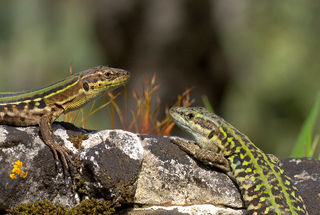Education
Learning from Others May Help Invasive Species Adapt
The Italian wall lizard may look innocuous, but it’s a master invader.
Posted December 5, 2018
The Italian wall lizard (Podarcis sicula) is a more cosmopolitan species than its name suggests. Native to the Italian Peninsula and Adriatic coast, the small lizard has been introduced worldwide and can now be found in Europe, North Africa, and across the United States.
These lizards possess a few traits that contribute to their success as invaders. One, they tend to use trees and human structures as refuges, leading to accidental transportation. Two, they are adaptable when it comes to habitat use, being found in natural areas, agricultural environments, and urban areas.
Now, researchers have demonstrated another advantage: Italian wall lizards can exploit social learning from other species to gain information about new environments. In a new paper, an international team of researchers argue for social learning as an underappreciated, advantageous mechanism facilitating invasions.

For the experiment, the researchers collected Italian wall lizards and assigned them to either the social learning group or the control group. The lizards assigned to the social learning group were paired with either another Italian wall lizard or a common lizard of another species with overlapping range (Bocage’s wall lizard, Podarcis bocagei). Each pair shared an enclosure divided by both a fixed transparent barrier and a removable opaque barrier.
The Italian wall lizards had to solve a task in which they were presented with three dishes with different colored lids. Only one dish (the blue one) contained a live mealworm treat. Lizards in the control condition had to figure out the task for themselves; those in the social learning group observed their partner, who was previously trained to open the blue lid to get to the mealworm, through the transparent barrier as they performed the task.
“We had lizards that could observe another lizard (from the same or a different species) obtaining the food from the blue dish before they themselves could make a choice, and we had other lizards that had no lizard demonstrating how the task could be solved,” says Isabel Damas-Moreira of Macquarie University, one of the paper’s co-authors. “The task is ecologically relevant because efficient foraging is crucial for an animal’s survival in a novel environment.”
Damas-Moreira and her colleagues found that Italian wall lizards that observed a demonstrator made fewer errors and performed the task better than those without demonstrators. What’s more, it did not seem to matter whether the demonstrator was another Italian wall lizard or a different species.
The ability to learn from others, including individuals of different species, may give animals an edge in new environments, influencing their invasive success.
“If a species can learn from resident animals, those native to the new place they have encountered, it can be like a shortcut to learn all sorts of things about the new environment, such as where to find food or good shelters and what places to avoid,” says Damas-Moreira.
As with other invasive species, the Italian wall lizard has been introduced to many different places by hitchhiking in human transportation and cargo. Future invasions to other new environments are probable. Damas-Moreira says it is crucial to understand how Italian wall lizards, as well as other invasive species, are so good at establishing and settling in new locations. A species’ ability to learn from others might be a factor that scientists studying biological invasions have to consider.
References
Damas-Moreira, I., Oliveira, D., Santos, J. L., Riley, J. L., Harris, D. J., and Whiting, M. J. (2018). Learning from others: An invasive lizard uses social information from both conspecifics and heterospecifics. Biol Lett 14: 20180532. doi: 10.1098/rsbl.2018.0532.


